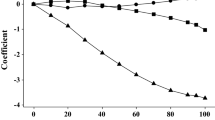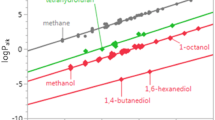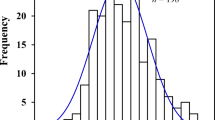Abstract
A new atom-additive method is presented for calculating octanol/water partition coefficient (log P) of organic compounds. The method, XLOGP v2.0, gives log P values by summing the contributions of component atoms and correction factors. Altogether 90 atom types are used to classify carbon, nitrogen, oxygen, sulfur, phosphorus and halogen atoms, and 10 correction factors are used for some special substructures. The contributions of each atom type and correction factor are derived by multivariate regression analysis of 1853 organic compounds with known experimental log P values. The correlation coefficient (r) for fitting the whole set is 0.973 and the standard deviation (s) is 0.349 log units. Comparison of various log P calculation procedures demonstrates that our method gives much better results than other atom-additive approaches and is at least comparable to fragmental approaches. Because of the simple methodology, the `missing fragment' problem does not occur in our method.
Similar content being viewed by others
References
Hansch, C. and Fujita, T., J. Am. Chem. Soc., 86 (1964) 1616.
Hansch, C., Bjorkroth, J.P. and Leo, A., J. Pharm. Sci., 76 (1987) 663.
Hansch, C. and Muir, R.M., Nature, 194 (1964) 178.
Leo, A., Chem. Rev., 93 (1993) 1281.
Rekker, R.F., The Hydrophobic Fragment Constant, Elsevier, New York, NY, 1977.
Rekker, R.F. and Mannhold, R., Calculation of Drug Lipophilicity, VCH, Weinheim, 1992.
Hansch, C. and Leo, A., Substituent Constants for Correlation Analysis in Chemistry and Biology, Wiley, New York, NY, 1979.
Leo, A., Comprehensive Medicinal Chemistry, Vol. 4, Pergamon, Oxford, 1990.
Klopman, G., Li, J.-Y., Wang, S. and Dimayuga, M., J. Chem. Inf. Comput. Sci., 34 (1994) 752.
Meylan, W.M. and Howard, P.H., J. Pharm. Sci., 84 (1995) 83.
Suzuki, T. and Kudo, Y., J. Comput.-Aided Mol. Design, 4 (1990) 155.
Broto, P., Moreau, G. and Vandycke, C., Eur. J. Med. Chem., 19 (1984) 71.
Ghose, A.K., Pritchett, A. and Crippen, G.M., J. Comput. Chem., 9 (1988) 80.
Convard, T., Dubost, J.-P. and Le Solleu, H., Quant. Struct.-Act. Relat., 13 (1994) 34.
Kellogg, G.E., Semus, S.F. and Abraham, D.J., J. Comput.-Aided Mol. Design, 5 (1991) 545.
Abraham, D.J. and Kellogg, G.E., J. Comput.-Aided Mol. Design, 8 (1994) 41.
Wang, R., Fu, Y. and Lai, L., J. Chem. Inf. Comput. Sci., 37 (1997) 615.
Hansch, C., Leo, A. and Hoekman, D. Exploring QSAR: Hydrophobic, Electronic, and Steric Constants, Vol. 2, American Chemical Society, Washington, DC, 1995.
SYBYL v6.4, Tripos Associates, St. Louis, MO, 1998. http://www.tripos.com/
Mannhold, R. and Dross, K., Quant. Struct.—Act. Relat., 15 (1996) 403.
Furet, P., Sele, A. and Cohen, N.C., J. Mol. Graph., 6 (1998) 182.
Author information
Authors and Affiliations
Corresponding author
Rights and permissions
About this article
Cite this article
Wang, R., Gao, Y. & Lai, L. Calculating partition coefficient by atom-additive method. Perspectives in Drug Discovery and Design 19, 47–66 (2000). https://doi.org/10.1023/A:1008763405023
Issue Date:
DOI: https://doi.org/10.1023/A:1008763405023




